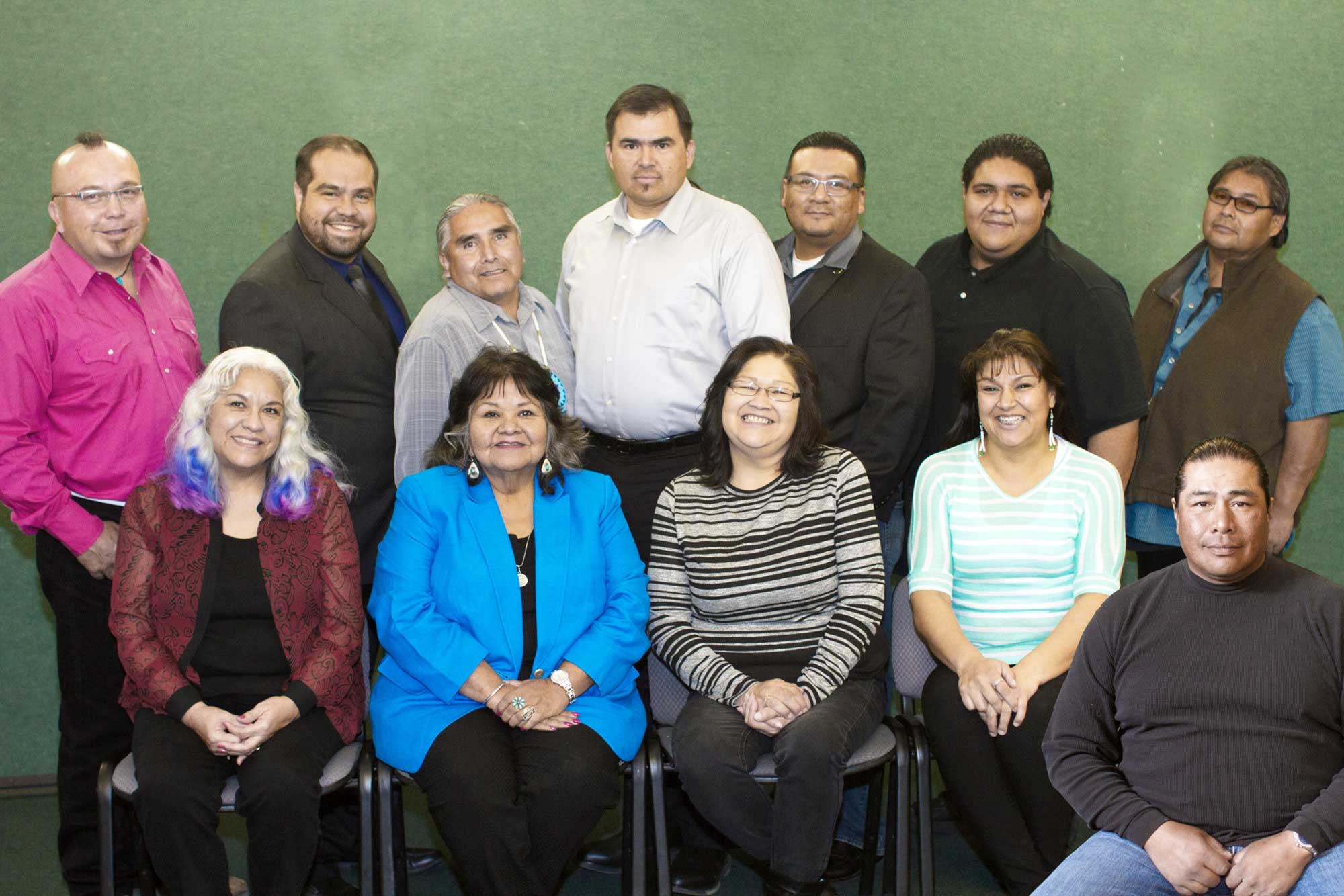The Washoe Tribe is a federally recognized Indian tribe organized under the Indian Reorganization Act of June 18, 1934, as amended, to exercise certain rights of home rule and to be responsible for the general welfare of its membership. Tribal history extends an estimated 9,000 years in the Lake Tahoe Basin and adjacent east and west slopes and valleys of the Sierra Nevada range. The present day Washoe Tribe has deep roots in the past, radiating from Lake Tahoe, a spiritual and cultural center, and encompassing an area that stretches from Honey Lake to Mono Lake. This aboriginal area was positioned directly in the path of explorers, immigrants, and gold-seekers that were bound for California in the United States’ westward migration. Only a few short years after the great 1849 immigration earlier migrants returned to Washoe lands to stay and develop the valleys and mountains of the Sierra Nevada. The total occupation of the Washoe People’s former lands took only a few short years. Before occupation, the Washoe people lived a seasonal and nomadic life of hunting and plant gathering. Summer was spent at Lake Tahoe hunting, fishing, and collecting medicinal plants/roots and berries for the winter season. Fall was spent in the Pine Nut Mountains, gathering and celebrating pine nut harvest, a staple food source. Winter and spring found the tribe in the valleys of the eastern Sierra including present-day Carson Valley, Washoe Valley, and Eagle Valley.

Back row, from left to right: Vice-Chairman of Stewart Community, Stan Smokey; Off-Reservation Representative Jeremy Steele; Carson Colony Vice-Chairman Chad Malone; Washoe Tribal Council Chairman Neil Mortimer; Off-Reservation Representative Mahlon Machado; Dresslerville Community Chairman Reuben Vasquez; Carson Colony Chairman Gary Nevers.
Front fow, from left to right: Stewart Community Chairwoman Jacqueline Steele; Vice-Chairwoman of the Washoe Tribal Council; Reno-Sparks Representative Lorraine Keller; Dresslerville Community Councilwoman Lisa Christensen; and Hung A Lel Ti Community Chairman Irvin Jim.
Washoe Tribe Media Releases
Washoe Tribe 2016 Annual Report
Washoe Tribe Newsletter January/February 2017
Washoe Tribe Newsletter September/October 2016
Washoe Tribe Newsletter May/June 2016
Washoe Tribal Programs
The Washoe Tribal government successfully operates a variety of programs through a self-governance compact under the Office of Tribal Self Governance. Below is a brief overview of some of the Tribal programs that the Washoe Tribe oversees.
The Washoe Tribal Health Clinic
The WTHC is a Title V operated Indian Health Center. Eligibility for the IHS Tribal Self-Governance Program is very selective; to be eligible to participate in the Tribal Self-Governance Program (TSGP), a Tribe must: (1) Complete a Planning Phase--Each Tribe is required to complete a planning phase to the satisfaction of the Tribe. This planning phase must include legal and budgetary research and internal Tribal government planning and organizational preparation relating to the administration of health care programs; (2) Request Participation in the IHS Tribal Self-Governance Program Each Tribe to be served must submit a Tribal resolution or other official action by the governing body of the Tribe requesting participation in the TSGP; (3) Demonstrate Three Years of Financial Stability and Financial Management Capability For the three years prior to participation in the TSGP, the Tribe must show evidence that there have been no uncorrected significant and material audit exceptions in the required annual audit of the Tribe's Self-Determination Contracts or Self-Governance Funding Agreements with any Federal agency.
A Tribe may also choose to authorize another Indian Tribe, an inter-Tribal consortium, or a Tribal Organization to participate in the TSGP on its behalf (see 25 U.S.C. §458aaa(b)). For additional information on eligibility for the TSGP, please see Section 503 of the Indian Self-Determination and Education Assistance Act (ISDEAA), 25 U.S.C. §458aaa-2, and the accompanying regulations found at 42 C.F.R. §137.15-26.
Funding Opportunities - Cooperative Agreements
Title V of the ISDEAA provides the OTSG statutory authority to offer Planning and Negotiation Cooperative Agreements to assist Tribes in planning and negotiations activities associated with the IHS TSGP. A Cooperative Agreement is a form of grant, in that all of the same requirements and procedures apply. However, the main difference between the two award instruments is the degree of Federal programmatic involvement. Cooperative Agreement awards involve much more substantive Federal program specific involvement than a grant.
The WTHC is located on the Washoe Reservation in Dresslerville, NV and provides optometry, general dentistry, family practice, x-ray services, audiology, chiropractic services, pharmacy, mental health, diabetes prevention, podiatry, referrals, and many other services to meet the needs of the Washoe Tribe.
The Washoe Tribe Tribal Historic Preservation Office (THPO)
The THPO office is dedicated to preserving the culture of the Washoe Tribe through means of consultation with state and federal agencies. In 1992, the U.S. Congress adopted amendments to the National Historic Preservation Act (P.L. 102-575) that allow federally recognized Indian tribes to take on more formal responsibility for the preservation of significant historic properties on tribal lands. Specifically, Section 101(d)(2) allows tribes to assume any or all of the functions of a State Historic Preservation Officer (SHPO) with respect to tribal land. The Washoe Tribe THPO assumes the role of the SHPO regarding Washoe funerary objects and NAGPRA issues.
As a formal participant in the national historic preservation program, the tribe assumes official responsibility for a number of functions aimed at the preservation of significant historic properties. Those functions include identifying and maintaining inventories of culturally significant properties, nominating properties to national and tribal registers of historic places, conducting Section 106 reviews of Federal agency projects on tribal lands, and conducting educational programs on the importance of preserving historic properties.
In accordance with Section 101(d)(2), the tribes on the National Park Service' list have formally assumed the responsibilities of the SHPO for purposes of Section 106 compliance on their tribal lands. They have designated Tribal Historic Preservation Officers (THPOs) whom Federal agencies consult in lieu of the SHPO for undertakings occurring on, or affecting historic properties on, tribal lands.
The Washoe Tribe Environmental Department
Assistance is provided under this program only for activities which the agency determines are appropriate to carry out the purposes of the Indian Environmental General Assistance Program Act of 1992, Public Law 102-497, Section 11, 42 USC 4368B, as amended, Public Law 103-55.
The annual Indian General Assistance Program (GAP), funded by the Environmental Protection Agency, offered aid to federally-recognized tribes up to $110,000. The primary purpose of these assistance agreements is to support the developmental elements of a core environmental program. The WEPD is focused on preservation and protecting the lands and rivers throughout the Washoe Reservations.
Washoe Tribe Cultural Resources Department
The CRD is comprised of two components: the language preservation office and the cultural resource office. The Washiw language is taught by tribal members in our communities, with lessons aimed at preserving the language. The Language Program of the CRD is responsible for language instruction, revitalization and preservation.
The Cultural Resource Department (CRD) is responsible for managing cultural affairs within the Washoe Tribe. The CRD has an advisory council comprised of Washoe elders and seniors called the Washoe Cultural Resources Advsiory Council (WCRAC). Cultural activities include brief overview of the Washoe history, beading, flint knapping, fishing, making arrowheads, learning how to make traditional Washoe foods and basketry, and many other aspects to revitalize and preserve the Washoe culture.
The Washoe Elder Center
The Elder's Center of the Washoe Tribe operates off Tribal general funds, and seeks to improve the wellness of the elderly population of the Washoe Tribe through a variety of services, such as culturally relevant activities, language preservation, and participation in the "Elders Site Council." Services include homebound meals, in-home caretaker services, and in partnership with the Washoe Tribal Health Center (WTHC), a variety of physical activities to promote health are available as well.
The Washoe Tribe Head Start Program
The Head Start Program administers and provides early intervention services to children ages 3-5, that meet eligibility requirements. There are two sites, one on the Dresslerville reservation and one on the Stewart reservation. The program helps children succeed through educational services, wellness services, as well as immersion into the Washiw language.
The Washoe Community Councils
The Community Council's were established under the Constitution of the Washoe Tribe, Article III, Section 2. Each community has adopted "Articles of Association," pursuant to the Washoe Tribe Constitution, Article VII, Section 1, and shall make every effort to improve the welfare and protect the interests of the residents of their respective communities.
Carson Colony Community Council: located in Carson City, NV, the Community Council consists of the Community Chairman Gary Nevers, Vice-Chairman Chad Malone, and Councilmembers Leticia "TIsh" Fillmore, Ellen Fillmore, and Bernadette Neito.
Dresslerville Community Council: located in Dresslerville, NV, the Community Council consists of the Community Chairman Rueben Vasquez, Vice-Chairman Willie Smokey, and Councilmembers Julie Barr, Lisa Christensen, and Elvia McDonald.
Stewart Community Council: located at the south end of Carson City, NV, the Community Council consists of the Community Chairwoman Jacqueline Steele, Vice-Chairman Stan Smokey, and Councilmembers Richard Burchett, Darryl Kizer, and Alex Barr.
Woodfords Community Council: located in Markleeville, CA, the Community Council consists of the Community Chairman Irvin Jim, Vice-Chairwoman Deirdre Jones Flood, and Councilmembers Geoff Ellis and Daniel Christensen.

